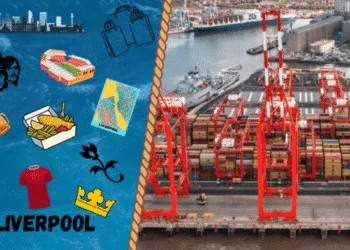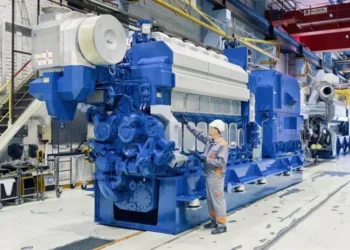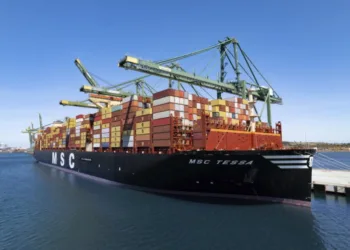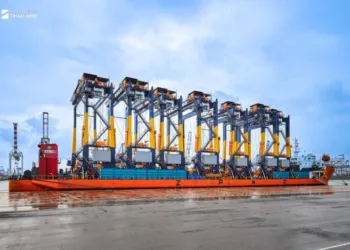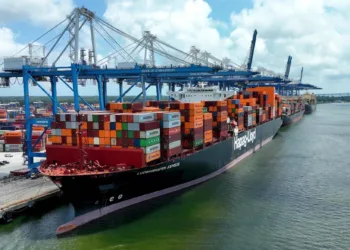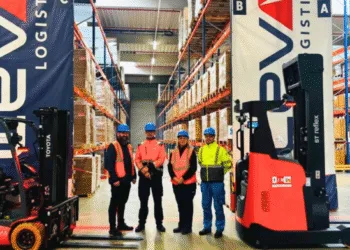Punit Oza on the business sector’s impossible tightrope. “When governments pull the trigger, companies take the bullet,” he writes.
In the escalating trade conflict between the United States, China, and their respective allies, a troubling paradox has emerged: nation-states wage economic warfare while the business sector—their primary weapon—bears the consequences. Like arrows fired from a bow, tariffs and trade restrictions fly between capitals, but the bow itself—the network of companies, supply chains, and commercial relationships painstakingly built over decades—strains under forces it never anticipated and cannot control.
The trade war that began in earnest during Trump’s first term has roared back to life in 2025 with renewed intensity. In recent months alone, the United States has imposed tariffs reaching up to 245% on Chinese imports along with penal port fees for Chinese controlled and owned vessels calling US ports, while China has retaliated with export restrictions on critical rare earth minerals and its own retaliatory port tariffs for US controlled ships calling China. The U.S. suspended some reciprocal tariffs temporarily in May 2025, maintaining a baseline 10% levy, but by October had threatened an additional 100% tariff in response to China’s rare earth controls. This tit-for-tat escalation has created a volatile environment where the rules of international commerce shift not quarterly, but weekly.
The arsenal
Modern trade wars employ an increasingly sophisticated arsenal. Beyond traditional tariffs, governments now deploy export controls, investment restrictions, technology transfer limitations, and strategic resource embargoes. The United States has targeted Chinese technology companies with sanctions while simultaneously restricting exports of critical software. China has responded by controlling exports of rare earth elements essential to everything from smartphones to electric vehicles to military systems.
These measures share a common characteristic: they transform private commercial relationships into instruments of foreign policy. A semiconductor manufacturer in Taiwan, an automotive parts supplier in Germany, or a rare earth processor in Vietnam suddenly finds itself navigating not just market conditions but geopolitical fault lines. The bow—these businesses and their intricate web of relationships—becomes both weapon and casualty.
The precarious tightrope
For multinational corporations, the challenge is existential. Companies that spent decades optimizing global supply chains for efficiency now face the impossible task of simultaneously optimizing for geopolitical resilience, national security considerations, and regulatory compliance across hostile jurisdictions. The tightrope they walk is suspended over an abyss of contradictory demands.
Consider Apple, which relies heavily on Chinese manufacturing but serves markets worldwide. Or automotive manufacturers with components sourced from dozens of countries, suddenly facing cascading tariff exposures. In early 2025, global supply chain anxiety reached what analysts described as “near breaking point” before a temporary U.S.-China tariff pause in May. Major retailers warned of empty shelves and unsustainable business models under the tariff regime.
The practical challenges are staggering. Companies must maintain detailed country-of-origin documentation for every component, anticipate regulatory changes that arrive with little warning, and make billion-dollar manufacturing location decisions based on political calculations rather than economic fundamentals. A factory that made perfect sense in 2023 becomes a liability in 2025. A supplier relationship cultivated over twenty years becomes untenable overnight.
This also applies to the maritime industry, which thrives on globalisation and international exposure. An average ship owner domiciled or controlled by US or Chinese or EU interests has customers in all these countries and more. So if its country’s foreign minister calls for tougher sanctions on another country, in which the owner has customers, this will eventually have a negative impact on business for sure, irrespective of market economics and competitiveness. The mix of customers, suppliers, tonnage providers and vendors will be shaken up in due course.
The human cost
Beyond balance sheets and supply chain diagrams lie human relationships. Business partnerships between American and Chinese firms, forged through years of collaboration, face unprecedented strain. Executives who built careers on cross-border commerce find themselves explaining to boards why political risks now trump commercial logic. Engineers and managers who’ve worked as colleagues across continents watch as their organizations are forced to “de-risk” and “decouple.”
The vocabulary itself reveals the transformation. What was once simply “business” is now “geopolitical exposure.” “Partnerships” become “dependencies.” “Efficiency” gives way to “resilience.” This linguistic shift reflects a deeper reality: commercial relationships are being reconstructed through the lens of national security and great power competition.
The impossible calculations
Companies now face calculations that defy traditional business analysis. How do you balance the 30% cost advantage of Chinese manufacturing against the risk of 245% tariffs? How do you invest in Vietnam when it faces 46% U.S. tariffs as part of broader reciprocal trade measures? How do you plan when the regulatory landscape shifts faster than construction timelines?
Some organisations are attempting to diversify supply chains, a process called “China Plus One” or nearshoring. Others are regionalising operations, creating separate supply chains for different trading blocs. Still others are lobbying furiously for exemptions—a strategy that has yielded mixed results, as seen when the Trump administration issued electronics exemptions after imposing massive tariffs.
None of these strategies is truly satisfactory. Diversification is expensive and time-consuming. Regionalisation sacrifices economies of scale. Lobbying for exemptions creates uncertainty and competitive advantages based on political access rather than business merit. Every option involves accepting significant costs or risks that would have been unthinkable a decade ago.
Fragmentation
What emerges from this chaos is not a temporary disruption but a fundamental restructuring of global commerce. The integrated global supply chains that defined the late 20th and early 21st centuries are fracturing into competing economic spheres. Companies are being forced to choose sides or maintain parallel operations at enormous cost.
This fragmentation extends beyond supply chains to research and development, technology standards, and even talent acquisition. Chinese and American engineers increasingly work on diverging technology platforms. European companies try to position themselves as neutral but find that impossible in practice when forced to choose between compliance regimes. The seamless flow of goods, services, capital, and talent that characterised globalisation is being replaced by a world of borders, restrictions, and strategic competition.
This fragmentation will create challenges for the set maritime business plans but open up new opportunities. Recent examples are Seaspan and Pacific Basin shifting their registered offices from Hong Kong to Singapore. It is important that China should see this as a pure economic decision rather than a political one and it must not strain the Singapore-China relations in any manner. If it does that, this can have huge ramifications for entire maritime Singapore and the industry ecosystems.
The policy disconnect
Perhaps most frustratingly for businesses, the architects of these trade wars—government officials and policymakers—often seem disconnected from the operational realities their decisions create. A tariff announcement takes minutes; restructuring a supply chain takes years. An export restriction can be implemented immediately; finding alternative sources of rare earth elements or advanced semiconductors may be impossible at any price.
Policymakers speak of “bringing manufacturing home” or “securing supply chains” without fully grappling with the interdependencies that make modern production possible. A semiconductor requires dozens of specialised inputs from multiple countries. An electric vehicle contains thousands of components with complex supply chains. You cannot simply “reshore” these industries—they exist as global networks or not at all.
Walking forward on the tightrope
For companies, there is no good path forward, only varying degrees of difficult compromise. The most sophisticated organisations are developing scenario planning capabilities, maintaining flexibility to pivot as political winds shift, and building in redundancy despite the cost. They’re investing in government affairs functions and geopolitical risk analysis. They’re learning to factor political risk into every decision at a level once reserved for operating in obviously unstable regions.
Some are finding creative solutions: dual sourcing from approved and restricted regions, final assembly in neutral countries, or technology licensing arrangements that satisfy conflicting requirements. But these solutions are expensive, inefficient, and fundamentally defensive. They represent risk management, not value creation.
The broader cost
The trade war’s toll extends beyond individual companies to innovation, consumer welfare, and global economic growth. Research collaborations are terminated. Joint ventures dissolve. The free exchange of ideas that drives technological progress is constrained. Consumers face higher prices. Developing nations lose access to markets and investment. The specialisation and efficiency gains from comparative advantage are surrendered to the logic of strategic autonomy.
Nations may claim victory when they successfully “protect” industries or “reshore” manufacturing, but these victories often come at costs that dwarf the benefits. The resources devoted to maintaining duplicate supply chains, the innovations not pursued due to restricted collaboration, the efficiency losses from forced localisation—these represent an enormous deadweight loss to the global economy.
The bow that cannot be unstrung
The metaphor of arrows fired from the bow of business reveals a fundamental problem: the bow was never designed to be a weapon of state conflict. The business sector evolved to optimise for efficiency, innovation, and mutual benefit through exchange. Commercial relationships were built on trust, complementary capabilities, and shared incentives to create value.
Nation-states have now conscripted this system for geopolitical purposes it was never meant to serve. The bow strains under the tension, threatening to break rather than launch arrows. Companies walk their precarious tightrope, trying to maintain relationships and operations across a fragmenting world, serving conflicting masters who view their success or failure purely through the lens of national interest.
Until governments recognise that weaponising commerce destroys the very instrument they hope to wield, companies will continue this impossible balancing act. They will do their best to navigate contradictory demands, maintain operations across hostile divides, and preserve what relationships they can. But make no mistake: with each escalation, each new tariff, each additional restriction, the bow weakens. And when it finally breaks, everyone—businesses, consumers, and the nations themselves—will bear the cost.




